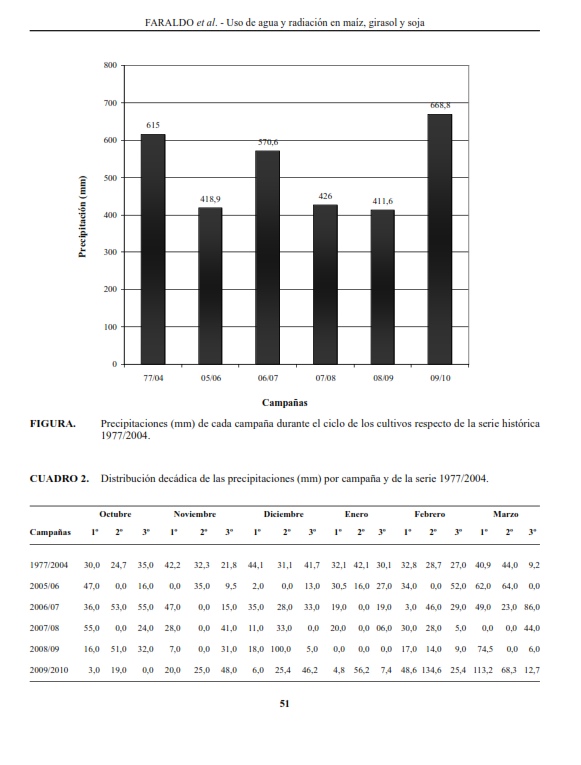Efficiency of water and radiation use in maize, sunflower and soybean, in the oriental region of la pampa, Argentina
Abstract
Efficiency in the water (WUE) or radiation (RUE) can use be represented by the amount of dry matter per unit of resource captured. Higher productivity of a crop can be achieved by increasing resource capture and/or bigger efficiency in its use. The work consisted of the study of the WUE and the RUE in three summer crops (maize, sunflower, and soybeans). Assays were performed in Catriló, La Pampa, Argentina, in the 2005/2010 period. Five campaigns were analyzed resulting maize, Zea mays, as the most efficient crop in water and radiation solar use. However, when drought conditions occur, sunflower, Helianthus annus, became the more efficient crop for the use of both resources. The soybean, Glycine max, in all analyzed maturity groups (MG) did not reach the WUE achieved by corn and sunflower. From the energy perspective, corn was the crop that produced the greatest amount of photoassimilates to achieve the performance of each campaign, followed by sunflower. It was concluded that for the studied period, both crops differ positively from soybeans, thus we can assert that they are the best performing in the semi-arid pampas.
Downloads
References
• Andrade, F. H., 1995. Analysis of growth and yield of maize, sunflower and soybean grown at Balcarce, Argentina. Field Crops Res. 41:1-12.
• Andrade, F. H. y J. M Gardiol. 1994. Sequía y producción de los cultivos de maíz, girasol y soja. Boletín técnico 132. EEA INTA Balcarce.
• Andrade, F. H., S. Uhart and Cirilo, A. 1993. Temperature affects radiation use efficiency in maize. Field Crop Res.32(1-2):17-25
• Andrade, F., A. Cirilo, S. Uhart y M. Otegui, M. 1996.Ecofisiología del cultivo de maíz. Ed.La Barrosa. Buenos Aires. Marzo. 292 p.
• Board, J. E. A., T. Wier and D. J. Boethel. 1995. Source strength influence on soybean yield formation during early and late reproductive development. Crop Sci. 35(4):1 104-1 110.
• Casagrande, G., G. Vergara, l. Belmonte, M. Fuentes, J. Y. Arnaiz y J. Forte Lay. 2011. Mapas de riesgo agroclimático para cultivos de la región oriental agropecuaria de la provincia de la pampa (Argentina). VI congreso cubano de Meteorología. Actas ISBN 978-959-7167-9-7. La Habana. Cuba.
• Castellarín, J. M., R. M. Pedrol y J. Andriani. 2005. Impacto del ambiente sobre el rendimiento de trigo en la campaña 2004/05 en Oliveros (Santa Fe). EEA oliveros. INTA.
• Cirilo A. G. and F. H. Andrade 1994. Sowing date and maize productivity: I. crop growth and dry matter partitioning. crop Science 34(4):1 039-1 043
• Earl, H. J. and R. F. Davis. 2003. Effect of drought stress on leaf and whole canopy radiation use efficiency and yield of maize. Agron. J. 95(3):688-696.
• Eckhoff, S. R. and M. R. Paulsen. 1996. Maize In: R.J: Henry y P.S. Kettwell (eds) cereal grain quality. chapman y Hall. UK. 77-112 pp.
• Hattendorf, M. J., M. S Redelf, B. Amos, l. R. Stone and R. E. Gwin. 1988. Comparative water use characteristics of six row crops. Agron. J. 80(1):80-85.
• Jiang, H. and D. B. Egli. 1995. Soybean seed number and crop growth rate during flowering. Agron. J. 87(2):264-267.
• Muchow, R. C. and R. Davis. 1988. Effect of nitrogen supply on the comparative productivity of maize and sorghum in a semi-arid tropical environment II: radiation interception and biomass accumulation. Fields Crops Res. 18(1):17-30
• Novoa, R. and R. S. Loomis. 1981. Nitrogen and plant production. In: J. Monteith and C. Webb (eds.) Soil Water and Nitrogen in Mediterranean-type Environments. Martinus Nijhoff/Dr., W. Junk Publishers, The Hague, The Netherlands. 177-204 pp.
• Otegui M.E., F.H.Andrade y E.E. Suero. 1995. Growth, water use, and kernel abortion of maize subjected to drought at silking. Field Crops Res. 40(2):87-94.
• Pasarella,V. y R. Savin. 2003. Características fisicoquímicas de los granos. Cap I In: producción de granos: bases funcionales para su manejo. Ed. FAUBA. UBA. 453 p.
• Penning de Vries, F. W. T., A. H. M. Brunsting and H. H. Van Laar. 1974. Products, requirements and efficiency of biosynthesis: a quantitative approach. Journal of Theoretical Biology 45(2):339-377.
• Slafer, G. y F. Andrade. 1993. physiological attributes related to the generation of grain yield in bread wheat cultivars released at different eras. Field crops Res. 31(3-4):351-367.
• Sinclair, T. R. and R. C. Muchow 1999. Radiation use efficiency. Adv. Agron. 65:215-265.
• Sinclair, T. R. and c. T. de Wit. 1975. Photosynthate and nitrogen requirements for seed production by various crops. Science 189(4202):565-567.
• Tollenar, M. and T. W. Bruulsema. 1988. Efficiency of maize dry matter production during periods of complete leaf area expansion. Agron. J. 80:580-585.
• Trapani, N., A. J. Hall, V. o. Sadras and F. Vilella. 1992. Ontogenetic changes in radiation use efficiency of sunflower (Hellianthus annuus l.) crop. Field Crop Res.29(4):301-316.
• Uhart, S. A. and F. H. Andrade. 1995. Nitrogen deficiency in maize. II. carbon-nitrogen interaction on kernel number and grain yield. Crop Science.35(5):1 384-1 389.
• Vega, C. R. C., V. O. Sadrás, F. H. Andrade and S .A. Uhart.2000. Reproductíve allometry in Soybean, Maize and Sunflower. Ann.Bot. (London) 85:461-468.
• Vergara, G.y A. Casagrande. 2002. Estadísticas agroclimáticas de la Facultad de Agronomía. Santa Rosa, La Pampa, Argentina. Revista de la Facultad de Agronomía. UNIpam. Vol. 13(1-2).





